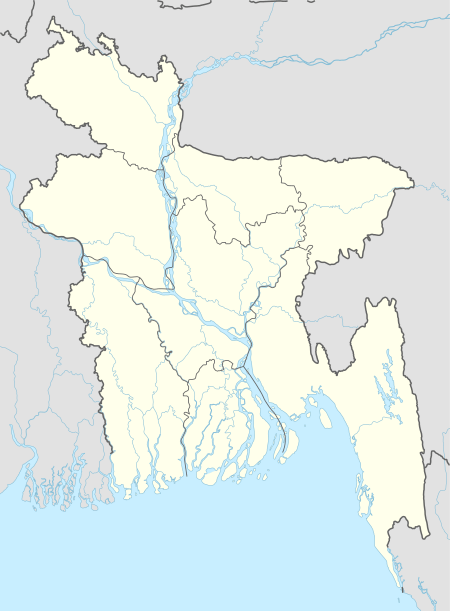Bhola Island
| Native name: ভোলা | |
|---|---|
 Bhola Bhola Island (Bangladesh) | |
| Geography | |
| Location | Bay of Bengal |
| Coordinates | 22°30′N 90°45′E / 22.500°N 90.750°ECoordinates: 22°30′N 90°45′E / 22.500°N 90.750°E |
| Area | 1,441 km2 (556 sq mi) |
| Length | 90 km (56 mi) |
| Width | 25 km (15.5 mi) |
| Highest elevation | 1.83 m (6 ft) |
| Highest point | Unnamed |
| Administration | |
| Demographics | |
| Demonym | Bholaya |
| Population | 1,758,000 |
| Pop. density | 1,162.39 /km2 (3,010.58 /sq mi) |
Bhola Island (also called Dakhin Shahbazpur) is the largest island of Bangladesh with an area of 1441 km². It is most of the land area of Bhola District in Barisal Division.[1]
Geography
It is situated at the mouth of the Meghna River. There are ferry and launch services from Dhaka and Barisal.[2]
The Island is 130 kilometres (81 miles) long and has a population of 1.7 million. A 1776 map indicates that it was ova-shapedl yet it is currently more elongated because of erosion by the Meghna River. It is only 6 feet above ocean level at the most elevated point.[3]
Cuisine
Bhola Island is known for its Buffalo curd (doi) which is unique in Bangladesh. The process that has been used has remained unchanged. It is made in traditional clay pots and the process takes 18 hours. It is popular in the Island and is served in special occasions such as weddings, festivals and other special occasions.[4]
Power
The Island has faced chronic power issues, although natural gas was discovered in Shahbazpur in 1994. The government decided to build a Power Plant which is expected to fully operational by August 2015. The state owned Power Grid Company of Bangladesh (PGCB) is installing a high voltage transmission line from Bhola Island to Borhanuddin Island.[5]
Media
There are 14 community radio stations on air.[6]
Natural Disasters
In 1970 it was affected by the devastating Bhola cyclone which completely devastated the southern half of the island and also destroyed the rice crop.
In 1995, half of the island became flooded, leaving 500,000 people homeless.[7]
In 2005, floods affected over half a million people on the island. Significant floods in the months and years before had caused severe erosion and led to a number of rivers overflowing. As of 2009 a number of the island's inhabitants were living in the slums of Dhaka.[8]
See also
References
- ↑ Md Sakhaowat Hossain (2012). "Bhola District". In Sirajul Islam and Ahmed A. Jamal. Banglapedia: National Encyclopedia of Bangladesh (Second ed.). Asiatic Society of Bangladesh.
- ↑ "About Bhola Island". Bhola's Children. Archived from the original on 8 February 2015. Retrieved 23 January 2015.
- ↑ Doyle, Alister. "Sonar to help slow Bangladesh erosion in Ganges delta". reuters.com. Reuters. Retrieved 23 May 2015.
- ↑ Seraj, Shykh (19 March 2015). "Buffalo Curd: Heritage of Bhola". The Daily Star. Retrieved 29 May 2015.
- ↑ Khan, Sharier (8 March 2015). "Big boost for Bhola". The Daily Star. Retrieved 29 May 2015.
- ↑ Rahman, Jahangir. "Community radio as change agent". thefinancialexpress-db.com. The Financial Express. Retrieved 23 May 2015.
- ↑ "In Flood-Prone Bangladesh, a Future That Floats", Emily Wax, Washington Post, September 27, 2007
- ↑ Catie Leary (16 October 2009). "7 places forever changed by eco-disasters: Bhola Island". Mother Nature Network. Retrieved 2 June 2017.